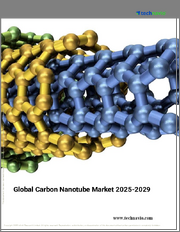
|
시장보고서
상품코드
1722513
탄소나노튜브(CNT) 시장 보고서 : 제품, 방법, 용도, 지역별(2025-2033년)Carbon Nanotubes Market Report by Product, Method, Application, and Region 2025-2033 |
||||||
세계 탄소나노튜브(CNT) 시장 규모는 2024년 66억 달러에 달했습니다. 향후 IMARC Group은 2033년까지 시장 규모가 240억 달러에 달하고, 2025-2033년 15.46%의 연평균 성장률(CAGR)을 보일 것으로 예측하고 있습니다. 전자 장치에서 전도성 첨가제에 대한 제품 수요 증가, 항공우주 및 자동차 산업을 위한 첨단 소재의 제품 적용 확대, 에너지 저장 및 환경 복원을 위한 지속 가능한 나노 소재 솔루션에 대한 관심 증가가 시장 성장의 주요 원동력이 될 것으로 예측됩니다.
탄소나노튜브(CNT) 시장 분석 :
- 주요 시장 성장 촉진요인 : 항공우주 산업에서의 괄목할 만한 성장과 음극선 조명 소자 및 웨이퍼 가공에 다중벽 탄소나노튜브가 광범위하게 채택되면서 시장 성장을 주도하고 있습니다.
- 주요 시장 동향 : 질병 치료 및 건강 모니터링에 활용되는 약물 전달 및 바이오센싱 시스템 생산에 대한 제품 수요 증가가 시장 성장에 긍정적인 영향을 미치고 있습니다.
- 경쟁 구도 : 탄소나노튜브(CNT) 시장의 주요 기업으로는 Arkema S.A., Cabot Corporation, Carbon Solutions Inc. Petrochemical Co.Ltd.,LG Chem Ltd.(LG Corporation),Nanocyl SA,OCSiAl,Ossila Ltd.,Raymor Industries Inc. 등이 있습니다.
- 지리적 동향 : 보고서에 따르면, 현재 아시아태평양이 세계 시장을 독점하고 있습니다. 중국은 아시아태평양에서 탄소 나노 물질의 최대 생산국이자 소비국입니다. 풍부한 원자재와 낮은 생산 비용으로 인해 중국의 탄소 나노 소재 시장의 성장을 뒷받침하고 있습니다. 또한, 이 지역의 전자 산업 확장에 CNT가 광범위하게 적용되면서 전체 시장 전망을 밝게 하고 있습니다.
- 과제와 기회: 탄소나노튜브(CNT) 시장은 높은 생산비용, 확장성 문제, 환경 및 건강에 미치는 영향에 대한 우려와 같은 문제에 직면해 있습니다. 그러나 지속적인 연구 발전, 다양한 산업 분야에서의 응용 확대, 전자, 항공우주, 에너지 저장 등의 분야에서 경량화 및 고성능 소재에 대한 수요 증가 등 기회는 풍부합니다.
탄소나노튜브(CNT) 시장 동향 :
자동차 및 전자제품의 제품 적용 확대
탄소나노튜브(CNT)는 뛰어난 기계적 특성, 경량성, 전기 전도성으로 인해 자동차 분야에 널리 사용되고 있습니다. 또한, 경량화 자동차에 대한 수요 증가도 CNT 시장을 활성화시키고 있습니다. 탄소나노튜브는 차체 패널, 섀시 부품, 내장 부품 등 자동차 부품에 사용되는 복합재료에 통합되어 강도와 내구성을 유지하면서 전체 무게를 줄일 수 있습니다. 예를 들어, 2023년 8월, 클레임슨 대학을 중심으로 한 연구팀은 NETL과의 공동 연구와 혼다의 지원을 받아 탄소섬유, 열가소성 수지 및 첨단 컴퓨터 설계를 사용하여 경량 차량 도어를 개발했습니다. 이 도어는 기존 스틸 도어보다 32% 가벼워 연방 안전 기준과 혼다의 고유한 안전 요구 사항을 충족하는 데 성공했습니다. 이 외에도 탄소나노튜브(CNT)는 뛰어난 전도성과 투명성으로 인해 터치스크린, 플렉서블 디스플레이, 인쇄전자제품에 사용되는 전도성 필름을 만드는데 전자 분야에서 널리 사용되고 있습니다. 또한 스마트폰, TV, 노트북, 태블릿 등 전자기기에 대한 수요 증가도 탄소나노튜브(CNT) 시장 점유율을 높이고 있습니다. 예를 들어, 2024년 세계 소비자 전자기기 시장 매출액은 1조 460억 달러에 달할 것으로 예측됩니다.
에너지 분야 제품 수요 증가
탄소나노튜브(CNT)는 높은 표면적과 전도성으로 인해 주로 태양전지, 연료전지 촉매, 수소저장 등 에너지 응용 분야의 촉매 담체로 주목받고 있습니다. 이에 따라 재생 가능 전력 용량을 확대하기 위해 여러 국가에서 재생 가능 전력 기술에 대한 투자가 증가하고 있으며, 이는 탄소나노튜브(CNT) 시장 전망에 긍정적인 영향을 미치고 있습니다. 예를 들어, 중국은 풍력 및 태양광에 대한 보조금을 단계적으로 폐지하고 있음에도 불구하고 2022년부터 2027년까지 전 세계 재생에너지 발전 용량의 거의 절반을 새로 도입할 계획입니다. 또한, 중국의 14차 5개년 계획의 야심찬 재생에너지 목표, 시장 개혁, 지방 정부의 확고한 지원은 재생에너지에 장기적인 수익의 확실성을 가져다주고 있습니다. 마찬가지로, 유럽에서는 2022년부터 2027년까지 재생에너지 발전 용량 확대 속도가 두 배로 증가할 것으로 예측됩니다. 미국에서는 2022년 8월 IRA가 통과되어 재생에너지에 대한 세액공제가 2032년까지 연장되었습니다. 인도에서도 신규 도입량이 두 배로 증가할 것으로 예측됩니다. 이는 태양광 발전이 주도하고 있으며, 2030년까지 500GW의 재생에너지 도입이라는 정부의 야심찬 목표를 달성하기 위해 실시되는 경쟁입찰이 그 원동력이 되고 있습니다. 지속 가능한 재생 에너지 통합에 대한 관심이 높아지면서 향후 몇 년 동안 탄소나노튜브(CNT) 시장의 수익이 증가할 것으로 예측됩니다.
확장하는 항공우주산업
CNT 기반 소재는 전자기 간섭(EMI)에 대한 차폐 효과가 매우 높아 항공기에 탑재된 섬세한 전자 시스템을 외부 전자기 방사선으로부터 보호하는 데 매우 중요합니다. 이 외에도 CNT는 항공우주 분야에 사용되는 복합재료를 보강하여 강성, 강도, 내구성 등 기계적 특성을 향상시키면서도 경량화를 유지할 수 있습니다. 또한, 확대되는 항공우주 산업과 전 세계적으로 증가하는 항공우주 시설도 탄소나노튜브(CNT) 시장 수요를 증가시키고 있습니다. 예를 들어, 2024년 3월 이스라엘 항공우주산업(IAI)은 인도에 항공우주서비스 인도(ASI)라는 새로운 항공우주방위회사를 설립할 것이라고 발표하였습니다. 인도 정부의 국가 독립 촉진 계획과 새로운 차원의 협력 관계를 보여주는 것이라고 합니다. 또한, 각국 정부 당국은 국방 역량을 강화하기 위한 이니셔티브를 취하고 자금을 지원하고 있으며, 이는 시장 성장을 더욱 촉진하고 있습니다. 예를 들어, 인도 정부는 2024년 3월 iDEX(ADITI)를 통한 혁신적 기술 개발 촉진(Acing Development of Innovative Technologies with iDEX) 계획을 시작했습니다. 이 제도는 국방 기술 연구개발 및 혁신을 위해 대상 스타트업에 최대 25조 루피의 보조금을 제공함으로써 중요하고 전략적인 국방 기술 혁신을 촉진하는 것을 목표로 하고 있습니다.
목차
제1장 서문
제2장 조사 범위와 조사 방법
- 조사 목적
- 이해관계자
- 데이터 소스
- 1차 정보
- 2차 정보
- 시장 추정
- 보텀업 접근
- 톱다운 접근
- 조사 방법
제3장 주요 요약
제4장 서론
- 개요
- 주요 업계 동향
제5장 세계의 탄소나노튜브(CNT) 시장
- 시장 개요
- 시장 실적
- COVID-19의 영향
- 시장 예측
제6장 시장 분석 : 제품별
- 다중벽 탄소나노튜브(MWCNT)
- 단층 탄소나노튜브(SWCNT)
제7장 시장 분석 : 방법별
- 화학 증착(CVD)
- 촉매 화학 증착법(CCVD)
- 고압 일산화탄소 반응
- 기타
제8장 시장 분석 : 용도별
- 폴리머
- 전기 및 전자 공학
- 에너지
- 기타
제9장 시장 분석 : 지역별
- 북미
- 미국
- 캐나다
- 아시아태평양
- 중국
- 일본
- 인도
- 한국
- 호주
- 인도네시아
- 기타
- 유럽
- 독일
- 프랑스
- 영국
- 이탈리아
- 스페인
- 러시아
- 기타
- 라틴아메리카
- 브라질
- 멕시코
- 기타
- 중동 및 아프리카
- 시장 내역 : 국가별
제10장 SWOT 분석
- 개요
- 강점
- 약점
- 기회
- 위협
제11장 밸류체인 분석
제12장 Porter의 Five Forces 분석
- 개요
- 바이어의 교섭력
- 공급 기업의 교섭력
- 경쟁 정도
- 신규 진출업체의 위협
- 대체품의 위협
제13장 가격 분석
제14장 경쟁 구도
- 시장 구조
- 주요 기업
- 주요 기업 개요
- Arkema S.A
- Cabot Corporation
- Carbon Solutions Inc.
- Cheap Tubes Inc.
- Jiangsu Cnano Technology Co. Ltd.
- Kumho Petrochemical Co. Ltd.
- LG Chem Ltd.(LG Corporation)
- Nanocyl SA
- OCSiAl
- Ossila Ltd.
- Raymor Industries Inc.
- Showa Denko K.K.
The global carbon nanotubes market size reached USD 6.6 Billion in 2024. Looking forward, IMARC Group expects the market to reach USD 24.0 Billion by 2033, exhibiting a growth rate (CAGR) of 15.46% during 2025-2033. The increasing product demand for conductive additives in electronic devices, growing product applications in advanced materials for aerospace and automotive industries, and rising interest in sustainable nanomaterial solutions for energy storage and environmental remediation, are primarily driving the market growth.
Carbon Nanotubes Market Analysis:
- Major Market Drivers: Significant growth in the aerospace industry and the widespread adoption of multi-walled carbon nanotubes for cathode-ray lighting elements and wafer processing are primarily driving the growth of the market.
- Key Market Trends: The increasing product demand for the production of drug delivery and biosensing systems that are utilized for the treatment of diseases and monitoring health is positively impacting the market growth.
- Competitive Landscape: Some of the leading carbon nanotubes market companies are Arkema S.A, Cabot Corporation, Carbon Solutions Inc., Cheap Tubes Inc., Jiangsu Cnano Technology Co. Ltd., Kumho Petrochemical Co. Ltd., LG Chem Ltd. (LG Corporation), Nanocyl SA, OCSiAl, Ossila Ltd., Raymor Industries Inc., and Showa Denko K.K., among others.
- Geographical Trends: According to the report, Asia-Pacific currently dominates the global market. China is the largest producer and consumer of carbon nanomaterials in Asia-Pacific. The abundance of available raw materials and the low cost of production supported the growth of the carbon nanomaterials market in the country. Moreover, the extensive application of CNT in expanding the electronics industry in the region is creating a positive outlook for the overall market.
- Challenges and Opportunities: The carbon nanotubes market faces challenges such as high production costs, scalability issues, and concerns regarding environmental and health impacts. However, opportunities abound with ongoing research advancements, expanding applications in diverse industries, and increasing demand for lightweight, high-performance materials in areas like electronics, aerospace, and energy storage.
Carbon Nanotubes Market Trends:
Increasing Product Application in Automotives and Electronics
Carbon nanotubes (CNTs) are finding extensive use in automotive applications due to their exceptional mechanical properties, lightweight nature, and electrical conductivity. Moreover, the escalating demand for lightweight vehicles is also catalyzing the market for CNTs. Carbon nanotubes can be incorporated into composites used for vehicle parts such as body panels, chassis components, and interior parts, reducing overall weight while maintaining strength and durability. For instance, in August 2023, a research team led by Clemson University, in collaboration with NETL and with support from Honda, developed a lightweight vehicle door using carbon fiber, thermoplastic resin, and advanced computer design. This door is 32% lighter than a conventional steel door and successfully meets federal safety standards and Honda's specific safety requirements. Besides this, carbon nanotubes (CNTs) are extensively being utilized in electronics for creating conductive films used in touchscreens, flexible displays, and printed electronics due to their excellent electrical conductivity and transparency. Additionally, the rising demand for electronic gadgets, such as smartphones, televisions, laptops, tablets, etc., is also propelling the carbon nanotubes market share. For instance, in 2024, the revenue generated in the consumer electronics market worldwide amounted to a staggering US$ 1,046.0 Billion.
Growing Product Demand in the Energy Sector
Carbon nanotubes (CNTs) are gaining much attention as catalyst support for energy applications, primarily solar cells, fuel cell catalysts, and hydrogen storage, owing to their high surface area and conductivity. In line with this, various countries are increasingly investing in renewable power technologies to expand renewable power capacities, which is positively impacting the carbon nanotubes market outlook. For instance, China is planning to install almost half of the new global renewable power capacity over 2022-2027, despite the phase-out of wind and solar PV subsidies. Moreover, China's ambitious renewable energy targets in the 14th Five-Year Plan, market reforms, and solid provincial government support provide long-term revenue certainty for renewables. Similarly, the pace of renewable capacity expansion in Europe is expected to be double during 2022-2027. In the United States, the IRA was passed in August 2022 and extended tax credits for renewables until 2032, providing unprecedented long-term visibility for wind and solar PV projects. In India, new installations are also set to double. This is led by solar PV and driven by competitive auctions implemented to achieve the government's ambitious target of 500 GW of renewable power by 2030. The increasing focus on integrating sustainable and renewable energy is anticipated to propel the carbon nanotubes market revenue in the coming years.
Expanding Aerospace Industry
CNT-based materials are highly effective at shielding against electromagnetic interference (EMI), which is crucial for protecting sensitive electronic systems onboard aircraft from external electromagnetic radiation. In addition to this, CNTs can reinforce composite materials used in aerospace applications, enhancing their mechanical properties such as stiffness, strength, and durability while maintaining a low-weight profile. Furthermore, the expanding aerospace industry and the increasing number of aerospace facilities across the globe are also augmenting carbon nanotubes market demand. For instance, in March 2024, Israel Aerospace Industries (IAI) announced that they would be establishing a new aerospace defense company in India, named Aerospace Service India (ASI). IAI said the establishment of ASI demonstrated new levels of collaboration between the group and the Indian government's plans to promote national independence. Moreover, the government authorities of various nations are taking initiatives and providing funds to bolster defense capabilities, which is further bolstering the market growth. For instance, in March 2024, the Indian government launched the Acing Development of Innovative Technologies with iDEX (ADITI) scheme. This scheme aims to promote innovation in critical and strategic defense technologies by providing grants of up to Rs 25 crore to eligible start-ups for research, development, and innovation endeavors in defense technology.
Global Carbon Nanotubes Market Segmentation:
Breakup by Product:
- Multi Walled Carbon Nanotubes (MWCNT)
- Single Walled Carbon Nanotubes (SWCNT)
Multi Walled Carbon Nanotubes (MWCNT) holds the majority of the total market share
Multi-walled carbon nanotubes (MWCNTs) consist of several concentric layers of graphene rolled up to form a tube-like structure. Their unique architecture imparts exceptional mechanical strength, electrical conductivity, and thermal properties. MWCNTs find diverse applications in fields such as aerospace, electronics, materials science, and biotechnology due to their versatility and performance characteristics. Moreover, carbon nanotubes market statistics by IMARC indicate that the expanding automotive, electronics, and aerospace industries are bolstering the market for multi-walled carbon nanotubes. For instance, in January 2023, MG Motor India announced a US$ 100 Million investment to expand capacity. Similarly, in December 2022, Mahindra & Mahindra revealed plans to invest INR 10,000 crore (US$ 1.2 Billion) in an EV manufacturing plant in Pune, India. This investment emphasizes the growing significance of the EV sector. Furthermore, compared to single-walled carbon nanotubes (SWCNTs), MWCNTs often exhibit higher tensile strength and thermal stability, making them suitable for demanding applications requiring robust materials. Their multi-layered structure allows for tailored properties and functionality, offering versatility in engineering novel nanomaterial-based solutions. As a result, their increasing adoption is anticipated to propel the carbon nanotubes market's recent price in the coming years.
Breakup by Method:
- Chemical Vapor Deposition (CVD)
- Catalytic Chemical Vapor Deposition (CCVD)
- High-Pressure Carbon Monoxide Reaction
- Others
Chemical Vapor Deposition (CVD) method currently exhibits a clear dominance in the market
Chemical Vapor Deposition (CVD) is a method used to synthesize carbon nanotubes (CNTs) by introducing carbon-containing gases into a reaction chamber at high temperatures. The gases decompose, and carbon atoms precipitate onto a substrate, forming nanotubes. CVD offers control over CNT characteristics such as diameter, length, and alignment, making it a versatile and widely used technique in nanomaterials synthesis.
Breakup by Application:
- Polymers
- Electrical and Electronics
- Energy
- Others
Polymers account for the largest market share
Carbon nanotubes (CNTs) are utilized in polymers to enhance their mechanical, electrical, and thermal properties. They act as reinforcing agents, improving the strength, stiffness, and toughness of polymer composites. Additionally, CNTs can impart electrical conductivity to polymers, enabling the development of conductive plastics for applications such as flexible electronics and electromagnetic interference shielding. Their high thermal conductivity makes them suitable for enhancing the thermal properties of polymers in applications like heat dissipation materials and flame retardants.
Breakup by Region:
- North America
- United States
- Canada
- Asia-Pacific
- China
- Japan
- India
- South Korea
- Australia
- Indonesia
- Others
- Europe
- Germany
- France
- United Kingdom
- Italy
- Spain
- Russia
- Others
- Latin America
- Brazil
- Mexico
- Others
- Middle East and Africa
Asia-Pacific currently dominates the global market
The report has also provided a comprehensive analysis of all the major regional markets, which include North America (the United States and Canada); Asia Pacific (China, Japan, India, South Korea, Australia, Indonesia, and others); Europe (Germany, France, the United Kingdom, Italy, Spain, Russia, and others); Latin America (Brazil, Mexico, and others); and the Middle East and Africa. According to the report, Asia-Pacific currently dominates the global market.
The carbon nanotubes market overview by IMARC indicates that China is the largest producer and consumer of carbon nanomaterials in Asia-Pacific. The abundance of available raw materials and the low cost of production supported the growth of the carbon nanomaterials market in the country. Moreover, the extensive application of CNT in expanding the electronics industry across APAC countries like China and India is creating a positive outlook for the overall market. For instance, the Indian government is talking with prominent semiconductor companies to set up local manufacturing units. The government invited new applications for setting up Semiconductor Fabs and Display Fabs in India from June 2023 under the Modified Semicon India Programme with an outlay of INR 76,000 crore. Similarly, according to a report by the Japan Automobile Manufacturers Association (JAMA), the country produced 7,427,179 units of passenger cars and 1,286,414 units of trucks in 2022. All these factors are anticipated to positively impact the CNT market over the coming years.
Competitive Landscape:
The market research report has provided a comprehensive analysis of the competitive landscape. Detailed profiles of all major companies have also been provided. Some of the key players in the market include:
- Arkema S.A
- Cabot Corporation
- Carbon Solutions Inc.
- Cheap Tubes Inc.
- Jiangsu Cnano Technology Co. Ltd.
- Kumho Petrochemical Co. Ltd.
- LG Chem Ltd. (LG Corporation)
- Nanocyl SA
- OCSiAl
- Ossila Ltd.
- Raymor Industries Inc.
- Showa Denko K.K.
Key Questions Answered in This Report
- 1.What was the size of the global carbon nanotubes market in 2024?
- 2.What is the expected growth rate of the global carbon nanotubes market during 2025-2033?
- 3.What are the key factors driving the global carbon nanotubes market?
- 4.What has been the impact of COVID-19 on the global carbon nanotubes market?
- 5.What is the breakup of the global carbon nanotubes market based on the product?
- 6.What is the breakup of the global carbon nanotubes market based on the method?
- 7.What is the breakup of the global carbon nanotubes market based on the application?
- 8.What are the key regions in the global carbon nanotubes market?
- 9.Who are the key players/companies in the global carbon nanotubes market?
Table of Contents
1 Preface
2 Scope and Methodology
- 2.1 Objectives of the Study
- 2.2 Stakeholders
- 2.3 Data Sources
- 2.3.1 Primary Sources
- 2.3.2 Secondary Sources
- 2.4 Market Estimation
- 2.4.1 Bottom-Up Approach
- 2.4.2 Top-Down Approach
- 2.5 Forecasting Methodology
3 Executive Summary
4 Introduction
- 4.1 Overview
- 4.2 Key Industry Trends
5 Global Carbon Nanotubes Market
- 5.1 Market Overview
- 5.2 Market Performance
- 5.3 Impact of COVID-19
- 5.4 Market Forecast
6 Market Breakup by Product
- 6.1 Multi Walled Carbon Nanotubes (MWCNT)
- 6.1.1 Market Trends
- 6.1.2 Market Forecast
- 6.2 Single Walled Carbon Nanotubes (SWCNT)
- 6.2.1 Market Trends
- 6.2.2 Market Forecast
7 Market Breakup by Method
- 7.1 Chemical Vapor Deposition (CVD)
- 7.1.1 Market Trends
- 7.1.2 Market Forecast
- 7.2 Catalytic Chemical Vapor Deposition (CCVD)
- 7.2.1 Market Trends
- 7.2.2 Market Forecast
- 7.3 High-Pressure Carbon Monoxide Reaction
- 7.3.1 Market Trends
- 7.3.2 Market Forecast
- 7.4 Others
- 7.4.1 Market Trends
- 7.4.2 Market Forecast
8 Market Breakup by Application
- 8.1 Polymers
- 8.1.1 Market Trends
- 8.1.2 Market Forecast
- 8.2 Electrical and Electronics
- 8.2.1 Market Trends
- 8.2.2 Market Forecast
- 8.3 Energy
- 8.3.1 Market Trends
- 8.3.2 Market Forecast
- 8.4 Others
- 8.4.1 Market Trends
- 8.4.2 Market Forecast
9 Market Breakup by Region
- 9.1 North America
- 9.1.1 United States
- 9.1.1.1 Market Trends
- 9.1.1.2 Market Forecast
- 9.1.2 Canada
- 9.1.2.1 Market Trends
- 9.1.2.2 Market Forecast
- 9.1.1 United States
- 9.2 Asia-Pacific
- 9.2.1 China
- 9.2.1.1 Market Trends
- 9.2.1.2 Market Forecast
- 9.2.2 Japan
- 9.2.2.1 Market Trends
- 9.2.2.2 Market Forecast
- 9.2.3 India
- 9.2.3.1 Market Trends
- 9.2.3.2 Market Forecast
- 9.2.4 South Korea
- 9.2.4.1 Market Trends
- 9.2.4.2 Market Forecast
- 9.2.5 Australia
- 9.2.5.1 Market Trends
- 9.2.5.2 Market Forecast
- 9.2.6 Indonesia
- 9.2.6.1 Market Trends
- 9.2.6.2 Market Forecast
- 9.2.7 Others
- 9.2.7.1 Market Trends
- 9.2.7.2 Market Forecast
- 9.2.1 China
- 9.3 Europe
- 9.3.1 Germany
- 9.3.1.1 Market Trends
- 9.3.1.2 Market Forecast
- 9.3.2 France
- 9.3.2.1 Market Trends
- 9.3.2.2 Market Forecast
- 9.3.3 United Kingdom
- 9.3.3.1 Market Trends
- 9.3.3.2 Market Forecast
- 9.3.4 Italy
- 9.3.4.1 Market Trends
- 9.3.4.2 Market Forecast
- 9.3.5 Spain
- 9.3.5.1 Market Trends
- 9.3.5.2 Market Forecast
- 9.3.6 Russia
- 9.3.6.1 Market Trends
- 9.3.6.2 Market Forecast
- 9.3.7 Others
- 9.3.7.1 Market Trends
- 9.3.7.2 Market Forecast
- 9.3.1 Germany
- 9.4 Latin America
- 9.4.1 Brazil
- 9.4.1.1 Market Trends
- 9.4.1.2 Market Forecast
- 9.4.2 Mexico
- 9.4.2.1 Market Trends
- 9.4.2.2 Market Forecast
- 9.4.3 Others
- 9.4.3.1 Market Trends
- 9.4.3.2 Market Forecast
- 9.4.1 Brazil
- 9.5 Middle East and Africa
- 9.5.1 Market Trends
- 9.5.2 Market Breakup by Country
- 9.5.3 Market Forecast
10 SWOT Analysis
- 10.1 Overview
- 10.2 Strengths
- 10.3 Weaknesses
- 10.4 Opportunities
- 10.5 Threats
11 Value Chain Analysis
12 Porters Five Forces Analysis
- 12.1 Overview
- 12.2 Bargaining Power of Buyers
- 12.3 Bargaining Power of Suppliers
- 12.4 Degree of Competition
- 12.5 Threat of New Entrants
- 12.6 Threat of Substitutes
13 Price Analysis
14 Competitive Landscape
- 14.1 Market Structure
- 14.2 Key Players
- 14.3 Profiles of Key Players
- 14.3.1 Arkema S.A
- 14.3.1.1 Company Overview
- 14.3.1.2 Product Portfolio
- 14.3.1.3 Financials
- 14.3.1.4 SWOT Analysis
- 14.3.2 Cabot Corporation
- 14.3.2.1 Company Overview
- 14.3.2.2 Product Portfolio
- 14.3.2.3 Financials
- 14.3.2.4 SWOT Analysis
- 14.3.3 Carbon Solutions Inc.
- 14.3.3.1 Company Overview
- 14.3.3.2 Product Portfolio
- 14.3.4 Cheap Tubes Inc.
- 14.3.4.1 Company Overview
- 14.3.4.2 Product Portfolio
- 14.3.5 Jiangsu Cnano Technology Co. Ltd.
- 14.3.5.1 Company Overview
- 14.3.5.2 Product Portfolio
- 14.3.6 Kumho Petrochemical Co. Ltd.
- 14.3.6.1 Company Overview
- 14.3.6.2 Product Portfolio
- 14.3.6.3 Financials
- 14.3.6.4 SWOT Analysis
- 14.3.7 LG Chem Ltd. (LG Corporation)
- 14.3.7.1 Company Overview
- 14.3.7.2 Product Portfolio
- 14.3.7.3 Financials
- 14.3.7.4 SWOT Analysis
- 14.3.8 Nanocyl SA
- 14.3.8.1 Company Overview
- 14.3.8.2 Product Portfolio
- 14.3.9 OCSiAl
- 14.3.9.1 Company Overview
- 14.3.9.2 Product Portfolio
- 14.3.10 Ossila Ltd.
- 14.3.10.1 Company Overview
- 14.3.10.2 Product Portfolio
- 14.3.11 Raymor Industries Inc.
- 14.3.11.1 Company Overview
- 14.3.11.2 Product Portfolio
- 14.3.12 Showa Denko K.K.
- 14.3.12.1 Company Overview
- 14.3.12.2 Product Portfolio
- 14.3.12.3 Financials
- 14.3.12.4 SWOT Analysis
- 14.3.1 Arkema S.A



















